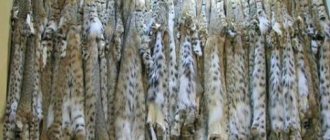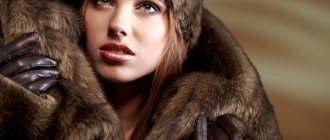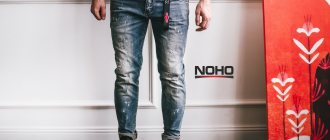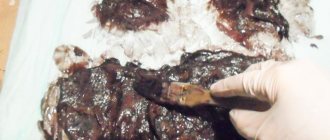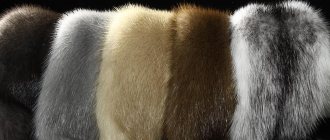Reasons for tinting at home
Fur by its nature can be artificial (synthetic) or natural. Sometimes it is quite difficult to distinguish them visually. But real fur will always cost more than faux fur. When buying various items of outerwear made of fur or leather, everyone hopes for their long service and perfect appearance. But time passes, and many people feel the need to paint part or all of the pile of the product. The reasons for this need may be the following factors.
Faux fur dyeing process
- Yellowed spots are a natural change in the pigmentation of natural hair under the influence of time.
- Poor-quality painting – initially the product could have been painted without following special technology.
- They used poor quality paint - unscrupulous manufacturers could save money on the paint they used for fur, so the item quickly lost its proper appearance.
- Household damage to color and wool during wear. Regardless of whether the fur is real or artificial, it can be accidentally damaged by the person himself. There are many reasons for this: they were burned, stained with paint, something was spilled, etc.
- Color fading - under the influence of ultraviolet light, the original shade of the pile can fade and fade.
Note! In any of the above cases, it is necessary to restore the color, that is, you need to dye the hair of the product.
Interesting read
Fur paint Fur-Fresh
The following products are most often used for coloring and tinting:
- hair dye;
- Furasol spray;
- aerosol Salamander;
- spray paint in cans from any manufacturer.
Note! There are not as many special products on the market as we would like. Despite the fact that Salamander fur dye and Furasol spray are very popular, you should first read reviews about their use. After all, someone could tint the fur of a fox or beaver, and you, for example, have an expensive mink. It is necessary to take into account all the nuances and properties of the pile itself.
Coloring with hair dye
Lock color
Updating fur clothing is a process that can be done independently. Coloring stages:
- wear work clothes, gloves, and a household respirator if the coloring solution has a specific odor;
- treat the inside (back side) with glycerin or petroleum jelly to avoid getting wet and deforming when drying;
- Moisten the pre-cleaned fur a little with a spray bottle and knead it with your hands, which will ensure a more even distribution of the dye;
- comb the fur with a sparse comb, dividing it into furrows before painting with a flat thick brush;
- leave the composition on the product for 30-40 minutes (for deep penetration into the pile);
- Wash off any remaining paint with a damp sponge soaked in warm water.
Pay attention to: Painting bars on windows at home: tips for beginners
After painting, be sure to lay out the fox fur coat on a flat surface, carefully straightening out all the details. This will protect the drying fur from deformation. If the fur is very wet, place an old cotton towel on the pile and press it firmly with your hands so that it absorbs excess moisture. Small items can be wrung out directly into the towel by rolling them with a roller:
- mittens, gloves with edges;
- ripped collars;
- hats;
- hood inserts.
Important! You cannot dry heavy fur items on hangers, only unfolded!
Gray fur can be partially dyed. “Coloring” looks beautiful by lightening the top layer (hydrogen peroxide or ammonia solution) and coloring the long pile with a dark shade. This will give the Arctic fox visual volume. Fur with partial “tinting” will look more luxurious. To dye the ends of a long pile, just walk with a wet mitten, then lightly touch the surface with a sponge dipped in dye and wash off the residue after the paint has set. But this method is only suitable for gray and white products. If the Arctic fox has turned yellow, it is better to make it red or black; it is useless to lighten it. It is recommended to treat it with a strong solution of potassium permanganate; it will look like steppe fox fur.
Some nuances of choosing paint
Important! First of all, consider the size of the product or the desired area of painting. The spray consumption will depend on this. Salamander fur paint in aerosol is easier to spray and dries very quickly. But aerosols are not so easy to reach under the fur. In order to evenly tint the entire product and the skin, it is better to process it completely using the dipping method.
Salamander faux fur paints are no less practical and durable. In terms of cost, they are practically no different from sprays and aerosols for natural fur. There are not many shades offered, mostly only the most popular colors, close to natural and classic. If you are not confident in your knowledge and skills, it is better to use the services of specialized workshops.
How can you dye fur?
Manufacturers claim that coloring occurs using complex technology using dyes and oxidizing agents. In fact, this technique is almost no different from dyeing at a hairdresser. It turns out that fur can be successfully updated with regular hair dye. After all, the structure of animal hair is very similar to human hair. The described method is safe for strong inner skin (skin from the underside of the pile), reliable and easy to perform. It is suitable for any type of natural pile.
Advice
It is not recommended to repaint new things. Painting is a way to extend the life of a worn item. As for new things, the procedure will only shorten their service life.
It is important to know that you cannot work with finished products (hats, fur coats, collars) without first stretching them. This is necessary in order to have access to the flesh.
Before you begin, you need to check the condition of the flesh. You need to moisten it with water and try to stretch it. If it does not stretch or tear, you can use paint. Otherwise, it's not worth the risk. You can tint the color with a tint hair balm, following the instructions. The bright and fresh shade lasts as long as paint. In this way, you can dye artificial hair, since it is not as durable as real hair, as well as silver fox, arctic fox, rabbit, and mink.
We recommend: How and with what can you quickly clean jewelry from darkening?
Causes of fur fading
Most varieties of natural fur are dyed; even natural shades of pile are tinted to add richness of color and shine. There are factors that lead to the loss of visual appeal of fur, and this is primarily fading.
Fur coat before and after painting
Trouble may occur for the following reasons:
- the appearance of yellow spots is due to natural pigmentation;
- violation of fur dyeing technology;
- use of low quality dye;
- exposure to sunlight and improper storage of fur products leads to fading of the pile;
- Careless handling of a fur coat can lead to the appearance of burns and stains.
If the fur has turned yellow, then before painting it is lightened with hydrogen peroxide, the treatment is carried out using a cotton pad soaked in the product.
Dyeing rabbit fur
How can you tint fur?
The expensive service of dyeing a fur product forces many to resort to carrying out the procedure themselves.
Coloring and tinting can be done at home using:
- spray, for example, Furasol;
- aerosol spray Salamander;
- hair coloring products.
Fur of different shades
Before purchasing fur dye, you must carefully read the instructions for using the product. The fact is that the choice will depend on the length of the fur, its shade, the area of paint coverage, and the type of fur.
If you need to refresh the fur, then choose paint in the same tone as the color of the fur. If a thorough painting is needed, then the color of the dye should be darker than the pile.
Dyeing agents for fur products
To dye fur at home, you first need to stock up on paint. These can be professional products sold in stores or on the Internet (dyes and sprays for fur, aerosols for suede), as well as hair dye.
Specialized paint for fur
A popular product is Salamander aerosol. Convenience and simplicity complement excellent results. Furasol tinting spray paint from Germany and German Teint Spray also have many positive reviews. Prices for professional products are high (from 1,500 rubles for a 300 ml can). But experts do not advise saving, since buying budget analogues often ends in disappointment - the color does not last long, marks remain on the neck and collars.
Material on topic! Paint for suede shoes
How to choose a paint shade
When dyeing fur of a dark shade, choose a dye that is a shade darker. For example, you need to update a brown mink: the paint should have a more saturated color. It is possible that you will have to add 0.5–1 tube of black paint.
Attention! It is more difficult to dye new clothes (not exposed to ultraviolet radiation) - the pigment is poorly absorbed into the material, which is why you have to periodically increase the paint concentration by adding dark colors.
On worn, heavily faded items, the effect is more noticeable. It sets faster and the resulting color is richer. The faded skin takes on an intense dark brown color in just 30–60 minutes. Experts advise painting the arctic fox in dark colors. To lighten, first use hydrogen peroxide.
Suitable hair dyes
Since professional products are expensive and you can’t always find them, ordinary hair dye will do. With significant savings, the visible result is not inferior to that produced by specialized sprays. The structure of the villi resembles human hair - hence the popularity of using cosmetics “for other purposes”.
Instead of specialized dye, you can use regular hair dye
Do not take paint that is too cheap - the more durable the effect, the longer you will wear a presentable item. The leaders are paints labeled “gray hair coverage.” Buy gentle ingredients - as in the case of hair, take the choice of dye seriously.
On a note! How to remove fresh and old hair dye from clothes, furniture and floors
So, what to paint with? Household hair dyes such as Prestige, Fara, Impression, Londa, Loreal have proven themselves in fur coloring. They are not afraid of the effects of precipitation, ultraviolet radiation, or mechanical manipulation. The color is durable and rich. The effect lasts for 2–3 years.
Advice! If you want to “refresh” light fur a little or give it a different shade, use Tonic tinted shampoo. The effect is not as long-lasting as after paint, but it opens up opportunities for frequent experiments with tinting a fur coat, hat or vest.
Aerosol Salamander
Aerosol fur paint is easy to use. However, it is necessary to take precautions: paint with the windows open, protect the table surface with oilcloth or polyethylene, put on gloves on your hands, and protect your respiratory tract with a respirator.
The aerosol is applied from a distance of 20 cm and evenly sprayed over the fur. The applied paint is evenly distributed using a comb or brush along the entire length of the pile.
The aerosol pigment penetrates well into the pile, making the color permanent. Salamander perfectly dyes both natural and artificial fur. Dye is suitable for mink fur, but it is better if a professional dyes expensive fur.
Useful tips for coloring
The complete renewal process consists of 3 stages: preparation, dyeing, drying. Do not forget to provide decent care during further use. To avoid spoiling the skin and achieve results, follow simple recommendations.
Preparatory stage
Purification is a key stage in transformation. The final result depends on the quality of cleaning. During wear, dirt gets clogged into the pile, which prevents the penetration of coloring pigments into the fiber. For better adhesion of the active composition, clean fur items with improvised means:
- Mix 1 liter of water, 2 tsp. soda, 1 tsp. ammonia and dishwashing detergent (any).
- Apply baby cream or glycerin to the inner (“bald” side of the skin), they will protect it from drying out during painting.
- Distribute the resulting homogeneous mixture evenly over the entire area of the skin, using a brush with stiff bristles.
- After 10 minutes, rinse thoroughly under running water and leave to dry in a horizontal position.
Spread the mixture evenly over the entire length
Place clothing outdoors or in a well-ventilated area. Do not hang it near a radiator or stove - the vest or fur coat may shrink in size and crack.
Main stage: painting
Dye natural fur like this:
- Place horizontally on the table.
- Check the “portability” of the composition on a miniature sample provided with purchase.
- Dilute the paint (the proportions are indicated in the instructions).
- Apply to sample. Do not exceed the time specified in the manual, otherwise the hair and hair may lose their appearance and become unwearable.
- If the resulting color satisfies you (sometimes the final shade differs from that stated on the box), proceed to the main painting.
- Painting fur involves intense, uniform movements with a brush dipped in paint. Grab the top and bottom layers, penetrating deep into the pile for an even shade.
Distribute the paint along the entire length
It will be inconvenient to dye an old fur coat with hair dye because of its large size. This method is relevant for small skins or hats. The optimal solution for oversized clothing is aerosols. Spray the contents, holding the can at a distance of 15–20 cm from the fur items. Comb your hair regularly, as after contact with the product it will stick together.
This is interesting! “Creative” painting is also popular, in which several colors of paint are mixed. They use hairdressing techniques by wrapping parts (like curls) in foil for a highlighting effect. A fashion trend is coloring, which is used to create leopard print. Cut out a stencil from thick cardboard, apply it to the area to be treated, paint it with brown paint, and paint the center black.
Final stage: drying
The processed material needs to be dried. Place your fur coats on wooden, wide, durable hangers that fit the size. Avoid metal utensils. Dry clothes in a warm room (but not near heating systems).
Dry your fur in a warm room
Before drying completely, apply a little glycerin and comb, setting the direction of the pile. The drying period takes from 2 to 5 days depending on the size of the item and thickness.
Hair dye
At home, a method of coloring hair with a hair product has proven itself. It is well suited for dyeing mink and arctic fox. The fur is pre-cleaned in any convenient way.
Mink paint is selected from a trusted manufacturer. It should be checked on a small piece of paper, which is usually included with the fur product.
To spray paint, use a spray bottle from a distance of 20-25 cm. The applied paint should be distributed with a brush. Drying is done with a hairdryer, but it is better to let it dry naturally. The shine of the pile is given with the help of hair balm, which will also soften the fur. After a few minutes, the balm must be removed with a damp cloth.
The hair dye stays on the fur pile for 8-9 months, then you need to repeat the dyeing.
This method is suitable for natural and artificial fur.
When purchasing a spray and aerosol, you should pay attention to the expiration date of the dye, and you should also purchase the dye in specialized stores to avoid disastrous results: uneven coloring, constant clogging of the spray bottle hole, unstable paint that will stain clothes and skin.
